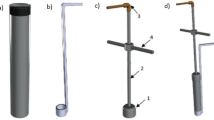Conclusions
-
1.
In the infiltration of composite materials in a gaseous environment there are narrow ranges of values of porosity, temperature, and treatment time within which the materials become vacuum-tight.
-
2.
The process of infiltration of MD15N.P Mo-Cu-Ni composite alloy consists of two stages: viscous capillary flow of the infiltrate, with the displacement of the primary matrix phase, and diffusional transport of the secondary matrix phase to the specimen center and of gases to the surface.
-
3.
If composite materials of this type are to be vacuum-tight, they must be infiltrated at a temperature not exceeding the temperature of formation of their refractory skeletons.
-
4.
The new method of studying the infiltration process, based on the use of indicator elements and on analysis of the matrix phase by selective dissolution, can be employed in development work on techniques for the infiltration of composite materials.
Similar content being viewed by others
Literature cited
V. B. Rabkin, R. F. Kozlova, N. V. Borun, and N. N. Blinova, Elektron. Tekh., Mater., Ser. 14, No. 6, 3–9 (1967).
R. F. Kozlova and V. B. Rabkin, Elektron. Tekh., Elektron. SVCh, Ser. 1, No. 5, 123–131 (1972).
B. A. Borok, I. N. Golikov, G. A. Goryaev, et al., Fiz. Khim. Obrab. Mater., No. 2, 101–112 (1968).
V. N. Eremenko and N. D. Lesnik, in: Surface Phenomena in Metals and Alloys and Their Role in Powder Metallurgy Processes [in Russian], Izd. Akad. Nauk Ukr. SSR, Kiev (1961), pp. 155–171.
V. N. Eremenko and N. D. Lesnik, “Infiltration of porous titanium carbide with cobalt, nickel, and their alloys with copper,” Poroshk. Metall., No. 1, 43–50 (1961).
V. N. Eremenko and V. V. Fesenko, in: Surface Phenomena in Metals and Alloys and Their Role in Powder Metallurgy Processes [in Russian], Izd. Akad. Nauk Ukr. SSR, Kiev (1961), pp. 178–187.
M. A. Sherstobitov, S. I. Popel', and B. V. Tsarevskii, “Procedure for determining the rate of penetration of melts into materials of capillary porosity,” Poroshk. Metall., No. 8, 50–54 (1965).
R. F. Kozlova, Elektron. Tekh., Mater., Ser. 6, No. 3, 123–131 (1973).
R. F. Kozlova, V. B. Rabkin, and N. V. Blinova, “Boundaries of the single-phase side fields in the system Mo-Cu-Ni in the solid state,” Poroshk. Metall., No. 2, 65–70 (1973).
R. F. Kozlova, V. B. Rabkin, L. Ya. Losev, and E. F. Pashchenko, “Boundary of the two-phase field of Mo(Ni, Cu) and Cu(Ni, Mo) solid solutions in the system Mo-Cu-Ni,” Poroshk. Metall., No. 5, 56–60 (1973).
Author information
Authors and Affiliations
Additional information
Translated from Poroshkovaya Metallurgiya, No. 8(176), pp. 9–14, August, 1977.
Rights and permissions
About this article
Cite this article
Kozlova, R.F., Rabkin, V.B., Filippenkova, L.S. et al. Production of vacuum-tight molybdenum-copper-nickel materials by liquid-phase sintering and infiltration. Powder Metall Met Ceram 16, 581–585 (1977). https://doi.org/10.1007/BF00790728
Received:
Issue Date:
DOI: https://doi.org/10.1007/BF00790728




